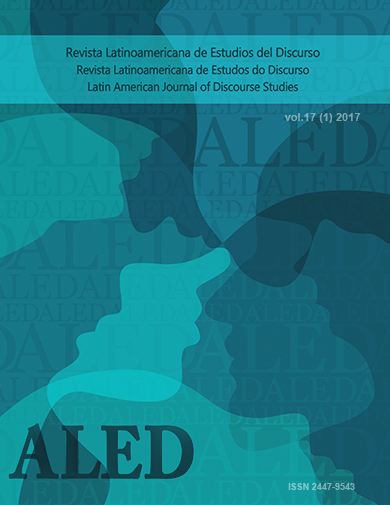La representación sociodiscursiva de la problemática habitacional en discursos legales del GCABA (período 2008-2009)
DOI:
https://doi.org/10.35956/v.17.n1.2017.p.27-52Palabras clave:
análisis crítico del discurso. representación sociodiscursiva. problemática habitacional. Ciudad Autónoma de Buenos Aires.Resumen
Este trabajo analiza cómo se construye la representación sociodiscursiva “problemática habitacional” en normas legales producidas por el Gobierno de la Ciudad Autónoma de Buenos Aires (GCABA), durante el período 2008-2009, referidas a personas en situación de pobreza. Esta elección radica en que estos discursos actúan sobre la problemática: a) creando acciones y estableciendo los lineamientos para ejecutarlas; y b) caracterizando tanto a los sujetos a quienes se dirigen dichas acciones como a la problemática en sí, en ambos casos sobre la base de un sistema de creencias que puede ser examinado mediante el Análisis Crítico del Discurso (ACD). El objetivo general posee dos ejes: a) determinar el rol del discurso en los conflictos sociales y mostrar la importancia que revisten las herramientas metodológicas para lograr ese fin; y b) aportar datos lingüísticos concretos de naturaleza cualitativa que permitan entender mejor cómo se elaboran las políticas públicas.
Descargas
Citas
De Miguel, E. 2000. [Disponible en http://www.ucm.es/info/circulo/no4/index.htm]. El texto jurídico-administrativo: Análisis de una orden ministerial. Círculo de Lingüística Aplicada a la Comunicación 4: s/n. [Consulta: 09 de marzo de 2016].
diver, W. 1981. On defining the discipline. Columbia University Working Papers in Linguistics 6: 59-117. fairclough, N. 1992. Discourse and social change. Cambridge: Polity Press.
Firbas, J. 1964. On defining the theme in functional sentence analysis. Travaux Linguistiques de Prague 1: 267-280.
Firbas, J. 1992. Functional sentence perspective in written and spoken communication. Cambridge: Cambridge University Press.
García da silva, D. E. 2007. Critical Discourse Analysis and the functional bases of language. En L. Barbara y T. B. Sardinha (eds.). Proceedings of the 33rdInternational Systemic Functional Congress, pp. 932-949. São Paulo: PUCSP.
González Salgado, J. A. 2009. El lenguaje jurídico del siglo XXI. Diario La Ley7209: 1-6.
Halliday, M. A. K y hasan, R. 1976. Cohesion in English. London-New York: Longman.
Halliday, M. A. K. y Matthiessen, C. M. I. M. 2004. An introduction to Functional Grammar (3rd ed.). London: Arnold.
Lavandera, B. 1986. Decir y aludir: una propuesta metodológica. Cuadernos del Instituto de Lingüística 1,1: 3-14.
Marchese, M. C. 2011, El texto como unidad de análisis socio-discursiva. Una propuesta a partir del Método sincrónico-diacrónico de análisis lingüístico de textos. Buenos Aires: Tersites.
Marchese, M. C. 2012. Análisis crítico de la representación discursiva de la vivienda en historias de vida de sujetos en situaciones de pobreza urbana y en discursos del Estado. El déficit habitacional en la Ciudad Autónoma de Buenos Aires en la posmodernidad. Manuscrito inédito: Universidad de Buenos Aires.
Marchese, M. C. 2014. Estado de excepción y políticas de emergencia: su impacto sobre la construcción simbólica del espacio habitacional. Cadernos de Linguagem e Sociedade (Papers on Language and Society) 15, 1: 117-140.
Mathesius, V. 1928. On linguistic characterology with illustrations from modern English. In Actes du Premier Congres International de Linguistes a la Haye, pp. 56-63.
Mathesius, V. 1939. On the so called Functional Sentence Perspective. Slovo a Slovestnost 5: 171-174.
Pardo, M. L. 1995. La gestación del texto. La emisión líder. Manuscrito inédito: Universidad de Buenos Aires.
Pardo, M. L. 1996. Derecho y lingüística. Cómo se juzga con palabras. Buenos Aires: Nueva Visión.
Pardo, M. L. 2001. La expresión discursiva del mandato. Análisis lingüístico del texto de la ley de reforma laboral argentina. Revista Iberoamericana de Discurso y Sociedad. Lenguaje en contexto desde una perspectiva crítica y multidisciplinaria 3, 2: 117-137.
Pardo, M. L. 2008. Una metodología para la investigación lingüística del discurso. En M. L. Pardo (ed.). El discurso sobre la pobreza en América Latina, pp. 55-78. Santiago: Frasis.
Pardo, M. L. 2011. Teoría y metodología de la investigación lingüística. Método sincrónico-diacrónico de análisis lingüístico de textos. Buenos Aires: Tersites.
Pardo, M. L. y buscaglia, V. 2008. Pobreza y salud mental desde el Análisis Crítico del Discurso. El aislamiento social y el deterioro comunicativo y cognitivo. Discurso & Sociedad 2, 2: 357-393.
Pardoabril, N. G. 2007. Cómo hacer Análisis Crítico del Discurso. Una perspectiva Latinoamericana. Santiago: Frasis.
Raiter, A., zullo, Z., Sánchez, K., Szretternoste, M., basch, M., Belloro, V., Pérez, S. I. y García, P. 2002. Representaciones sociales. Buenos Aires: Eudeba.
Raiter, A. 2003. Lenguaje y sentido común. Las bases de la formación del discurso dominante. Buenos Aires: Biblos.
Ramalho, V. y Resende, V. M. 2011. Análise de discurso (para a) crítica: o texto como material de pesquisa. Campinas: Pontes.real academia es pañola. 2014. Diccionario de la lengua española (23a ed.). [Disponible en www.rae.es].
Resende, V. M. y Ramalho, V. 2006. Análise de discurso crítica.São Paulo: Contexto.
Toulmin, S. 1958. The uses of argument. Cambridge: Cambridge University Press.
Van Dijk, T. A. 1993. Principles of Critical Discourse Analysis. Discourse & Society, 4, 2: 249-283.
Van Dijk, T. A. 2003. La multidisciplinariedad del análisis crítico del discurso: un alegato en favor de la diversidad. En R. Wodak y M. Meyer (comps.). Métodos de Análisis Crítico del Discurso, pp. 143-177. Barcelona: Gedisa.
Wodak, R. 2000. ¿La sociolingüística necesita una teoría social? Nuevas perspec-tivas en Análisis Crítico del Discurso. Revista Iberoamericana deDiscurso y Sociedad, 2, 3: 123-147.
Descargas
Publicado
Cómo citar
Número
Sección
Licencia

Esta obra está bajo una licencia internacional Creative Commons Atribución-NoComercial-SinDerivadas 4.0.
Los/as autores/as conservan los derechos de autor/a y garantizan a RALED el derecho de ser la primera publicación del trabajo al igual que licenciado bajo una Creative Commons Attribution License BY-NC-ND 4.0 que permite a otros compartir el trabajo con un reconocimiento de la autoría del trabajo, copiar y redistribuir el material en cualquier medio o formato.
Os/As autores/as conservam os direitos autorais e garantem a RALED o direito de ser a primeira publicação do trabalho licenciado por uma Creative Commons Attribution License BY-NC-ND 4.0 que permite compartilhar o trabalho com reconhecimento de sua autoria e cópia e redistribuição do material em qualquer meio ou formato.




